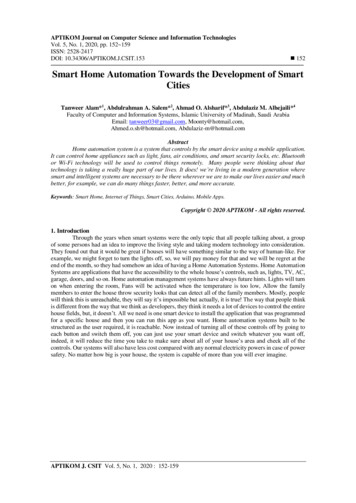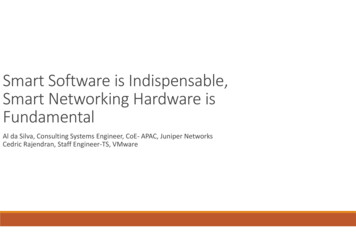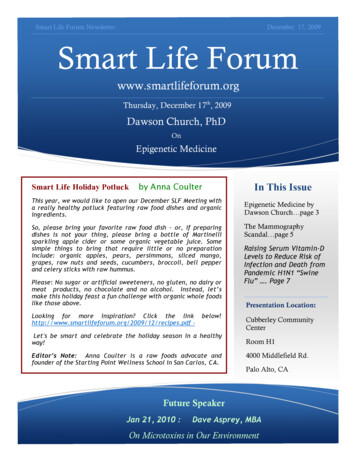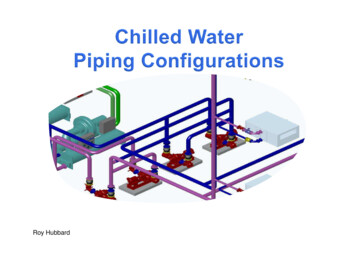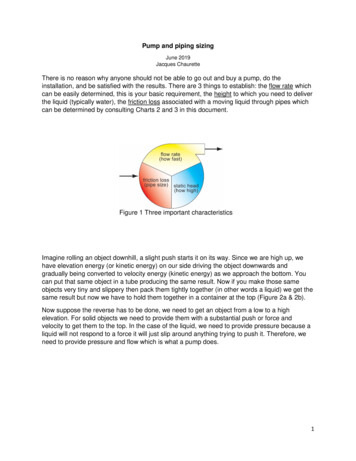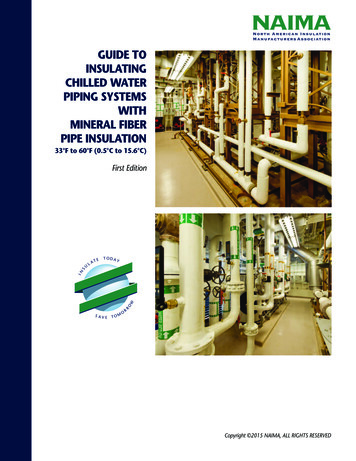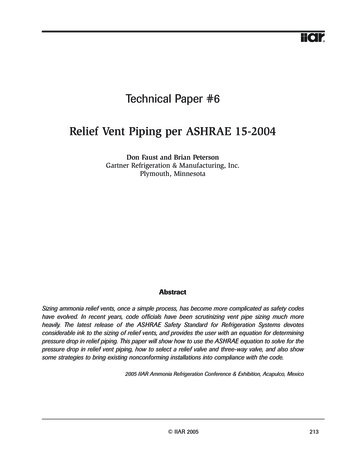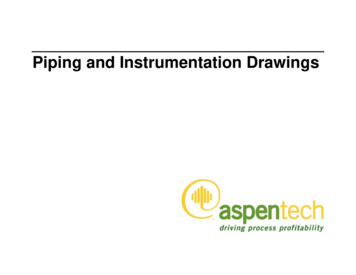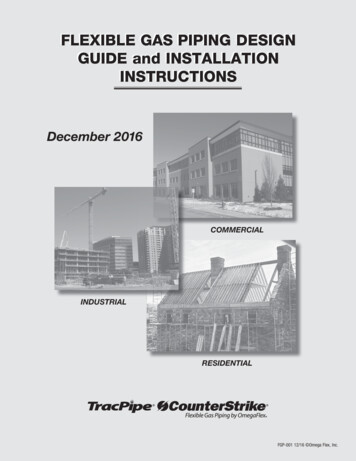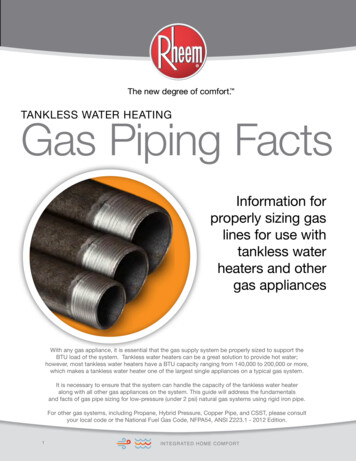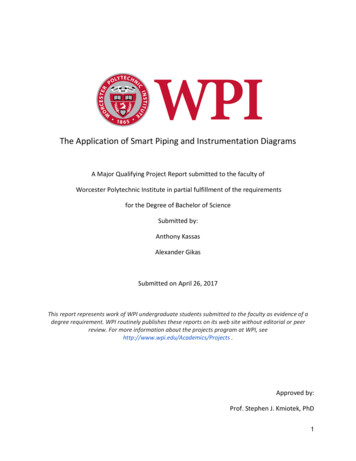
Transcription
The Application of Smart Piping and Instrumentation DiagramsA Major Qualifying Project Report submitted to the faculty ofWorcester Polytechnic Institute in partial fulfillment of the requirementsfor the Degree of Bachelor of ScienceSubmitted by:Anthony KassasAlexander GikasSubmitted on April 26, 2017This report represents work of WPI undergraduate students submitted to the faculty as evidence of adegree requirement. WPI routinely publishes these reports on its web site without editorial or peerreview. For more information about the projects program at WPI, seehttp://www.wpi.edu/Academics/Projects .Approved by:Prof. Stephen J. Kmiotek, PhD1
AbstractPiping and instrumentation diagrams (P&IDs) are a universal language spoken in the processengineering industry. They are the framework of engineering design, outlining process piping,unit operations, control systems, utility management, and the functioning relationship betweenthem within a given engineering facility. Intelligent piping and instrumentation diagrams havebeen created to ensure efficiency and organization in design processes through theincorporation of a back-end database of CAD drawings. In addition, intelligent piping andinstrumentation diagrams promote consistency amongst instrumentation and pipingdenotations within the process field. We worked alongside DPS Engineering to incorporateintelligent P&IDs into the design of a small scale biodiesel transesterification process. Toevaluate the potential application of intelligent P&IDs, we utilized the pilot unit operationslaboratory in WPI’s Goddard Hall. Through professional opinion as well as from our experience,we determined that intelligent P&IDs are an efficient organization tool for large scale projects;however, for small processes, such as the regarded biodiesel reactor, they are unnecessary.2
AcknowledgementsWe would like to thank the following people and organizations for their contributions:DPS EngineeringMike HansonTim FoleyWPIProfessor Stephen KmiotekProfessor William Clark3
Acronyms and NomenclatureCAD - Computer-Aided DesignHS - Hand SwitchISA - International Society of AutomationKOH - Potassium HydroxideLC - Level ControlP&ID - Piping and Instrumentation DiagramPFD - Process Flow DiagramPTFE - PolytetrafluoroethyleneSEC - Speed Element ControlTAC - True Adaptive ControlTCU -Temperature Control UnitTE - Temperature ElementTEC - Temperature Element ControlTT - Temperature TransmitterWE - Weight ElementWT - Weight Transmitter4
Table of ContentsAbstract . 2Acknowledgements . 3Acronyms and Nomenclature . 4Table of Figures . 7Introduction . 81.0.1 Overview . 81.02 Project Objectives . 9Background . 92.0.1 Computer-Aided Design . 92.0.2 Piping and Instrumentation Diagrams . 102.0.3 Process Flow Diagrams versus Piping Instrumentation Diagrams . 122.0.4 Intelligent Piping and Instrumentation Diagrams . 122.0.5 Biodiesel Production . 122.0.6 The Biodiesel Unit Operation . 13Research Questions and Methodology . 153.0.1 Project Objectives and Goals . 153.0.2 Project Objective Number One . 163.0.3 Project Objective Number Two . 173.0.4 Project Objective Number Three . 173.0.5 Project Objective Number Four . 19Results and Discussion . 204.0.1 Project Objective Number One . 204.0.2 Project Objective Number Two . 234.0.3 Project Objective Number Three . 264.0.4 Project Objective Number Four . 27Conclusions . 28Recommendations . 295.0.1 Recommendations for Intelligent P&ID Program Creators. 295.0.2 Recommendations for Future Projects and Studies . 305
Bibliography. 32Appendices . 34Appendix A – Smart P&ID Revisions . 34Appendix B – Equipment List – Database Quantities. 39Appendix C – Instrument List – Database Quantities . 42Appendix D – Line List – Database Quantities . 43Appendix E – Professional Interviews . 456
Table of FiguresFigure One – Biodiesel Transesterification Process . 13Figure Two – Process Flow Diagram . 21Figure Three – Piping and Instrumentation Diagram . 22Figure Four – Smart Piping and Instrumentation Diagram, Part 1 . 23Figure Five – Smart Piping and Instrumentation Diagram, Part 2 . 24Figure Six – Smart Piping and Instrumentation Diagram, Part 3 . 25Figure Seven – Database Equipment List . 26Figure Eight – Process Flow Diagram . 34Figure Nine – P&ID . 35Figure Ten – Smart P&ID Revision A . 36Figure Eleven – Smart P&ID Revision B . 37Figure Twelve – Smart P&ID Revision C . 38Figure Thirteen – Database Equipment List, Part 1. 39Figure Fourteen – Database Equipment List, Part 2. 40Figure Fifteen – Database Equipment List, Part 3 . 41Figure Sixteen – Database Instrument List . 42Figure Seventeen – Database Line List, Part 1. 43Figure Eighteen – Database Line List, Part 2 . 447
Introduction1.0.1 OverviewPiping and instrumentation diagrams (P&ID) are rudimentary in chemical engineering processdesign works. As a fundamental blueprint to each and every chemical plant and process, pipingand instrumentation diagrams offer a simplistic view on heavily quantified engineeringdevelopments, bridging the gap between process consultant engineers and constructionentities. P&IDs are regarded as a flow pattern, outlining the line, valve, equipment, andinstrument specifications aid engineers in developing full scale processes of all sorts. Theconceptualization of intricate processes is enhanced through the capabilities of P&IDs,including, but not limited to:Enumerating unit operation capabilities and frameworkMaintenance of piping, instrumentation, unit operations, and valves.Utility trackingControls engineeringUniformity among design engineersInstallation methodsPiping and instrumentation diagrams are standardized by the International Society ofAutomation Standard S5.1 (ISA) with respect to general formatting and process diagramsymbols. There, however, lies an inherent problem with the formulation of piping andinstrumentation diagrams. Each AutoCAD designer utilizes a unique method in theirconstruction of process schematics, resulting in an ununiformed series of P&ID pages of largescale processes. An entity taking on a project of greater magnitude with several tens of pages ofP&IDs cannot properly level the playing field without providing edits upon edits of material.Changes to process dynamics and operations must then be reflected in the agreeing MicrosoftExcel database of specifications. Process edits are not reflected universally under currentsoftware restrictions. This evolving problem is most evident under grander scale processes. This8
project seeks to explore the capabilities of intelligent piping and instrumentation diagrams, theefficiency of the technology, and the scale-up potential related to the related software. Abiodiesel transesterification process was studied in order to discern the plausibility of theseobjectives.1.02 Project ObjectivesThe goal of this project was to work alongside DPS Engineering to determine the applicability ofintelligent P&IDs into process engineering on small and large scales. Our major objectives wereto:1. Create an operation piping and instrumentation diagram that accurately depicts thebiodiesel transesterification operation in the Unit Operation Laboratory of Goddard Hall.2. Replicate the piping and instrumentation diagram in CADWorx. Retrieve Excel databaseof equipment lists and specifications.3. Determine the plausibility of scale up with regards to the biodiesel transesterificationoperation and other Smart P&ID implemented projects utilizing CADWorx andprofessional opinion.4. Assess the efficiency of Intelligent P&ID technology.We hope that intelligent P&IDs will prove to be a helpful tool in process engineering and that itbecomes a universally used program to better the industry.Background2.0.1 Computer-Aided DesignComputer-Aided Design (CAD) is a software program that was released in the 1960s with theintention to assist in the creation, modification, analysis and optimization in range of industries.1Utilized by architects, engineers, and artist, Computer-Aided Design enables an author toconceptually create an accurate 2-D vector based or 3-D solid based representation of atechnical drawing. CAD replaces drafting by hand with computer simulated drawing with1Market Business News – What is Computer-Aided Design or CAD9
greater precision. CAD is used to design houses, cars, unique products, and piping andinstrumentation diagrams. 2 AutoCAD is the predominant CAD platform used by operatingfacilities for piping and instrumentation diagrams.2.0.2 Piping and Instrumentation DiagramsPiping and instrumentation diagrams are the framework of engineering design, outlining theprocess piping, unit operations, control systems, utility management, and the functioningrelationship between them within a given engineering facility. A piping and instrumentationdiagram portrays unique symbol representation of components and instruments along withtheir functions and locations on a multipage document, employed for troubleshooting andmonitoring processes. P&IDs portray a layout scheme used by members of development teamsto accurately assess construction processes, maintenance guidelines, and the fundamentalblueprints of how a process may start up, operate, and shutdown. P&IDs are often consideredto be a liaison between equipment manufacturing and process construction and operation. Bythe definition provided by Lucid Chart, “P&IDs play an essential role in the process engineeringworld to show interconnectivity. P&IDs are invaluable documents to keep on hand, whetherthey’re used to streamline an existing process, replace a piece of equipment, or guide thedesign and implementation of a new facility.” 3 The unique attributes credited to the P&IDenable engineers and others involved in the process to responsibly attend to the process andunderstand the rudimentary dynamics of it.Piping and instrumentation diagrams include all controlled locks, mechanical equipment, andunit and unique piping labels. Flow directions are depicted to allow examiners to conceptualizeprocess pathways from storage vessels in the commencement of a chemical or biologicalprocess, to product and waste vessels downstream. The intended physical sequence of theequipment is displayed through the provided flow direction indicators. 4 Omitted from pipingand instrumentation diagrams are specificities of equipment and their usage, along with proper2AutoDesk – CAD SoftwareLucid – What are Piping and Instrumentation Diagrams?4Engineering ToolBox – P&IDs310
scaling, to an extent. Piping size and identification are noted, yet piping length is omitted inmost situations. Scaling between different unit operations and piping length are factors ofsafety and accessibility analyses, separate of piping and instrumentation diagrams. Piping andinstrumentation diagrams are physically implemented as depicted on the diagram; e.g., a valveshould be correctly rotated based on its positioning on the P&ID; a storage vessel should becorrectly aligned based on the positioning of the P&ID and a piping inlet into a unit operationshould not be constructed in an outlet. “It is noted that the P&IDs are to be suitable for a takeoff of the valves, reducers, branches, and instruments, but not for the take-off of piping andelbows” 5 With that being said, P&IDs cannot be “relied on as real models” due to their lack ofgeometric and scaling accuracy. 6 P&IDs often vary in design from creator to creator due to thelack of universal guideline. It is also customary to avoid the flow qualifications and extendeddisclaimers regarding the process in such a diagram.The usage of piping and instrumentation diagrams can assure safety protocol is being followedvia operation guidelines, as well as assure costs of maintenance and construction. Bydeveloping a standard operation guideline, a community of process employees can rightfullyadhere to provided rule parameters. P&IDs can yield an accurate feel of pricing with theplanning of all piping and unit operations. Despite inherent inconsistencies, piping andinstrumentation diagrams deliver measures of operation security, proper usage, as well as strictmaintenance and construction policy.2.0.3 Process Flow Diagrams versus Piping and Instrumentation DiagramsPiping and instrumentation diagrams diverge from process flow diagrams (PFD) through manyfacets. Provided by the International Society of Automation, “[A process flow diagram is a]drawing the shows the general process flow between major pieces of equipment of a plant andthe expected operating conditions at the target production rate.” 7 Containing supplementarydetail, P&IDs are considered to be a more advanced step into the design process, whereas PFDsare referred to as a bird’s eye view. Process flow diagrams show the interconnectivity of main5Unica Instrument Engineer’s Handbook – Process Measurement and AnalysisLucid – What are Piping and Instrumentation Diagrams?7 ISA – Control and Field Instrumentation Documentation611
equipment operations, yet omit detail further, as opposed to P&IDs. In addition, PFDs do notinclude ISA symbols, but are the evolution of most P&ID schematics.2.0.4 Intelligent Piping and Instrumentation DiagramsIn 1985 Intergraph introduced the first SmartPlant P&ID systems. 8 Intelligent P&IDs, or SmartP&IDs, are data driven CAD drawings with a back-end database. This database bridges otherapplications, which populate information and extract them from the drawings. It also allows thedesigner to manage the P&ID while focusing on the plant asset rather than the documentrepresentation. The information stored with each intelligent P&ID consists of the minimumrequired attributes for design, analysis, procurement, and maintenance. 9 The inputs areretrieved from process flow sheets, instrumentation schematics, equipment data sheets, valveand instrumentation specification sheets, and piping material specifications. It can be providedin the form of drawings and documents. A variety of software allows for visual representationof a given P&ID, as AutoCAD would provide, yet enables interactivity. Identification, physicalproperties, process responsibilities, utilities, current statuses, and miscellaneous informationcan be accessed through to touch of the computer mouse of the corresponding portion of theP&ID. Quoted from the producers of SmartPlant P&IDs, Intergraph describes the software as ameans to “help you develop and manage your P&IDs with a focus on the plant asset.helpingyou save money without compromising design quality or integrity.” 10 The hopeful outcome ofintelligent P&IDs is that it will save money, time, and reduce risk for the longevity of theconstruction and operation of the process.2.0.5 Biodiesel ProductionAs energy demands increase, and fossil fuels are limited, research is directed towardsalternative renewable fuels. Biodiesel is a favorable liquid biofuel alternative because it is made8Intergraph News – SmartPlant EnterpriseAll About CAD Conversion – What are Intelligent P&IDs10 Intergraph News – SmartPlant Enterprise912
from renewable resources, vegetable oil and methanol, and has lower emissions. 11 It is lesstoxic than table salt and biodegrades as fast as sugar. Produced domestically with naturalresources, its use decreases universal dependence on imported fuel and contributes toeconomic development. The increase of research on reducing biodiesel production costs hasstrengthened the industry, making it a strong competitor of petroleum based fuels.The production of biodiesel fuel is a multi-reaction process involving complex set of conditionsand controls. A preliminary step to biodiesel production is the chemical process known astransesterification, where glycerol is separated from oil with the use of methanol and a basecatalyst (KOH). The process leaves behind two products consisting of methyl esters andglycerol. Vegetable oil has an extremely high viscosity so it is not the most efficient whenburned, however transesterification converts the vegetable oil to biodiesel molecules that havesimilar properties to petroleum diesel fuel. Due to the great molecular similarities, thisalternative fuel has a chance of fulfilling the demands that diesel engine makes of its fuel. Thescope of this reporting of the biodiesel production process is limited to the transesterificationreaction noted above for the sake of creating an intelligent P&ID system.Figure 1: Biodiesel Transesterification ProcessAbove is the chemical reaction for the production of biodiesel from vegetable oil usingmethanol. Ethanol is an available substitute for methanol. When utilized, three methanol or11Biodiesel Basics – Biodiesel.org13
ethanol molecules react with triglyceride to form three molecules of ethyl esters. These methylor ethyl esters are the biodiesel products sought.2.0.6 The Biodiesel Unit OperationThe piping and instrumentation diagram generated replicates the biodiesel production unitoperation within the Worcester Polytechnic Institute, Goddard Hall second floor unit operationslaboratory. The diagram was computer emulated on AutoCAD to retrieve a schematic of theentire process.The biodiesel production process of interest encompasses a 500 milliliter Globe ChemicalReactor, with a glass jacket, used as a catalyst preparation reactor. The production unitoperations follow to a 500 milliliter Globe Chemical Reactor, with a glass jacket, used as aprocess reactor. Each reactor contains a pitched polytetrafluoroethylene (PTFE) blade propellerfor mixing purposes as well as a spring loaded valve which provides leak free sealing. The3reactors are connected via 16” ChemDurance Bio tubing, from the preparatory reactor lowermanual valve to the top of the process reactor. Each reactor has a respective temperatureelement (TE) and temperature transmitter (TT). Connected to each jacketed reactor is a1condenser loop. The 2” rubber tubing of the condenser loop carries sewer water to each HuberMiniStat temperature regulator from the jacket of each reactor and back to the jacket in orderto respectively control the designated process temperature. This process is regulated by thetemperature control unit (TCU) self-optimizing temperature element control (TEC) with atemperature error stability rate of 0.02 degrees Celsius. Heating capacity of the condenserreaches 1.5 kW and cooling capacity ranges from 0.42 to 0.05 kW.The stored process materials are held within 2000 milliliter Nalgene Erlenmeyer PolypropyleneFlasks. These stored process materials include methanol, ethano0l and vegetable oil. It is, again,worth noting that either methanol or ethanol is used during the process, not in conjunction.The potassium hydroxide (KOH) catalyst is manually inputted into the catalyst preparationreactor with the methanol or ethanol. The vegetable oil mixes with the catalytic reactor mixture14
in the process reactor. Generic weigh scales are used to track the weight of each stored processmaterial (aside from the catalyst) to regulate the input into the corresponding reactor.Regulation is completed by means of gravimetric dosing from the feed vessels on electronicbalances, utilizing a weight element (WE) and a weight transmitter (WT). Stored materials are3transferred from their respective flask to the designated reactor by 16” ChemDurance Biotubing.Watson Marlow SCI 323 peristaltic pumps transfer the contents of each piece of ChemDuranceBio tubing to their obligated location. There are three peristaltic pumps located in the unitoperation: one for the feed pumping of methanol or ethanol, one for the feed pumping ofvegetable oil, and one for the transfer of contents from the catalytic reactor to the processreactor. Each pump is associated with a speed element control (SEC) and a hand switch (HS). An3equivalent 16” piece of ChemDurance Bio tubing is attached to the manual spring valve at thebottom of the process reactor, in which a mixture of glycerol and biodiesel are gravimetricallytransferred to and separated in a Justrite Polyethylene 5 Gallon Quick-Disconnect DisposalSafety Can.Research Questions and Methodology3.0.1 Project Objectives and GoalsThe goal of our project was to work alongside DPS Engineering to determine if incorporatingintelligent P&IDs in process engineering is efficient and scalable. In order to accomplish thisgoal we pursued four objectives:1. Create an operation piping and instrumentation diagram that accurately depicts thebiodiesel transesterification operation in the Unit Operation Laboratory of GoddardHall.2. Replicate the piping and instrumentation diagram in CADWorx. Retrieve Excel databaseof equipment lists and specifications.15
3. Determine the plausibility of scale up with regards to the biodiesel transesterificationoperation and other Intelligent P&ID implemented projects utilizing CADWorx andprofessional opinion.4. Assess the efficiency of Intelligent P&ID technology.In this section, elaboration on these objectives and explanations regarding the necessaryprocess to complete these objectives will be discussed.3.0.2 Project Objective Number OneObjective One: Create an operation piping and instrumentation diagram, in AutoCAD, thataccurately depicts the biodiesel transesterification operation in the Unit Operation Laboratoryof Goddard Hall.Preliminary ResearchThe preliminary research conducted prior to the production of the process and instrumentationdiagram of the biodiesel transesterification process began with the familiarization withAutoCAD. As two novice CAD operators, adaptation to the program proved difficult, with plentyof hours of introductory practice being conducted. A thorough examination of features of theGoddard Laboratory biodiesel pilot plant was conducted. A rough PFD was conceptualized andsketched in order to further understand flow patterns and the major pieces of equipment.Tubing and equipment models and serial numbers were taken into account to determine exactspecifications of the entire process. Additionally, piping and instrumentation diagrams consistof several different detailed figures representing unit operations of a given operation. Withoutlicenses to obtain premade instruments, we had to examine pre-existing and industrystandardized P&ID symbols for unit operations.MethodThe piping and instrumentation diagram was completed in AutoCAD. Many drafts were made,due to uncertainty of various pieces of equipment. Re-creation of representational unitoperations as our own was conducted via our AutoCAD drawings. Once the major operations16
such as reactors, heat exchangers, pumps, and valves were drawn, we then connected them bypiping. Level and temperature controls were followed by the piping in order to place them in amore comprehensible manner. Arrows were also added to provide a direction in the processflow. Finally, we labeled the equipment with proper nomenclature to elaborate on the sizingand material of piping, as well as differentiate the duplicate instruments.Limitations and ObstaclesNot all information regarding the piping was at our exposure. Even with research, the exactmake and size of the condenser loop tubing was not apparent due to a language barrier of theproducer and us. With consulting from Professor William Clark, an estimate of the pipingdiameter and material was completed of said tubing line.We were exposed to many different alternate standardized drawings of specific instrumentswhen completing prior research. There is no one method in drawing a peristaltic pump;however there are abundant alternatives. The drawings we made were based off of theresemblance to the actual equipment.3.0.3 Project Objective Number TwoObjective Two: Replicate the piping and instrumentation diagram in CADWorx. Retrieve Exceldatabase of equipment lists and specifications.Preliminary ResearchPrior to utilizing CADWorx, there had to be a strong understanding of the program itself. DPSprovided us with a manual on operating and maneuvering through CADWorx. In order tosuccessfully complete this step, with the least amount of hiccups and errors, many questionswere asked. Approximately twenty hours were spent reading the manual, and speaking toemployees about instruction and applicable tips. Background research on the equipmentspecifications was also completed in order to maximize the advantage of intelligent P&IDs.17
MethodThe P&ID produced in AutoCAD was first uploaded through CADWorx. Once it was displayed,edits had to be made in order for the program to better understand the functions of thep
2 AutoDesk – CAD Software 3 Lucid – What are Piping and Instrumentation Diagrams? 4 Engineering ToolBox – P&IDs. 11 scaling, to an extent. Piping size and identification are noted, yet piping length is omitted in most situations. Scaling between different unit ope
